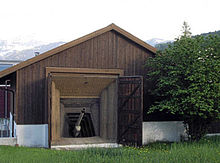Faulensee artillery plant
The Faulensee artillery plant (army designation "See" A 1954) is an artillery plant disguised as agricultural barns in the canton of Bern , which integrates its four weapon positions with their 10.5 cm artillery cannons perfectly into the townscape and is therefore only a military facility for the trained eye is recognizable.
The work
The four bunkers include
- Gun post
- Fire control center
- Accommodation for the team
- kitchen
- Engine room with ventilation and gas protection for fire control center and emergency power system
- Ammunition magazines for 800 shells each
- Technical room for collective mask protection of the gun crew.
The four bunkers are all connected to each other by a 160 meter long underground passage. Each had a bedroom for 6-7 men.
history
In the war year 1941, the shell of the factory was completed in a record construction time of around six months. This was followed by the technical installations and the installation of weapons, so that the plant could be handed over to the troops ready for use in mid-1943. Until the plant was completed, it was planned that a mobile artillery battery would have been deployed at the plant's location if there was a corresponding threat .
During the Cold War , the secret facility was an important base for the operational lockdown of the Reduit Brigade 21 .
The rapid development of the weapon systems, but also the changed threat, were the reason that the object was retired at the end of 1993 after a good 50 years of service. Since 2001, the interesting work, which is unique as a building type, can be viewed as a historical and cultural testimony of national importance.
Armament
In the Faulensee plant, only troop guns were used in active service, which were converted by the troops from the mobile spreading mounts to the parallel lever mounts. From 1948 the Faulensee artillery factory was permanently armed with 10.5 cm cannons of the 1935 L42 type as a permanently installed fortification gun. 4–5 rounds per minute could be fired per gun. The artillery position was operated by the heavy motor cannon battery 135 in 1940 and from 1941 by the heavy motor cannon battery 126.
team
In the 1970s there were 138 men, 20 of them for external defense, 24 for anti-aircraft protection and 2 motorists.
A gun crew consisted of 7-9 men:
- Gun leader
- Judge
- Lock keeper
- Tempierer
- Loader
- 1–2 ammunition carriers
- 1-2 storeys
Target area
With the Faulensee artillery plant, the Aare valley and the Gürbetal axis could be covered with fire as far as the Steffisburg and Seftigen areas . With blocking points in this area, an advancing enemy would have been stopped or at least delayed so that it would have been a worthwhile target for artillery fire.
literature
- Hans-Rudolf Schoch: Faulensee artillery plant. The artillery on the left bank of Lake Thun - in particular the Faulensee A1954 artillery plant . Frutigen 2011.
Web links
- Official website of the Faulensee Foundation and Association of Artillery Works
- Spiez Info from July 2007: Why fortresses and bunkers?
- Spiegel TV 2010: Swiss military bunkers Ennetberg, Faulensee etc.
Individual evidence
- ↑ Made by Tschanz, January 2020: The Faulensee cannons (video)
- ^ Fortress Oberland: A 1954 Artillery Works Faulensee BE
Coordinates: 46 ° 40 '29.9 " N , 7 ° 41' 51.4" E ; CH1903: 619816 / 169338



